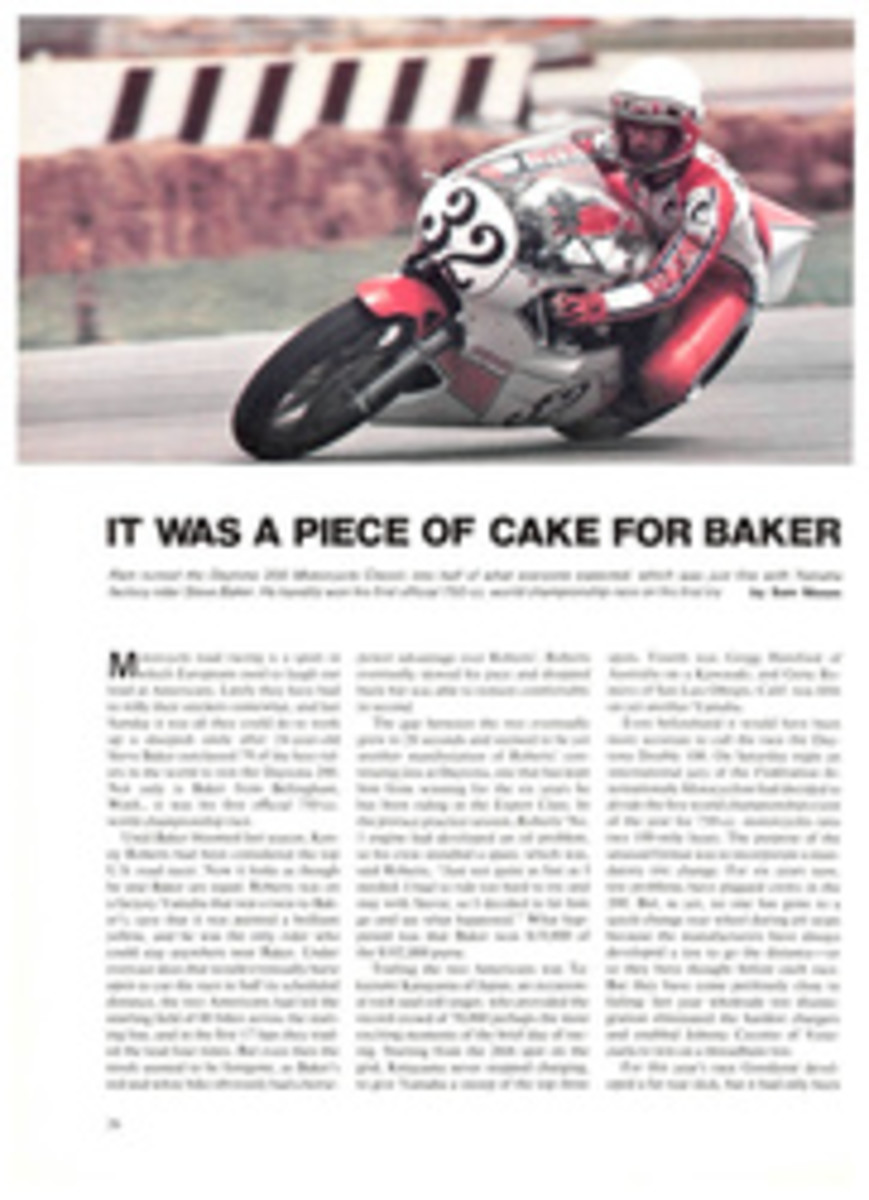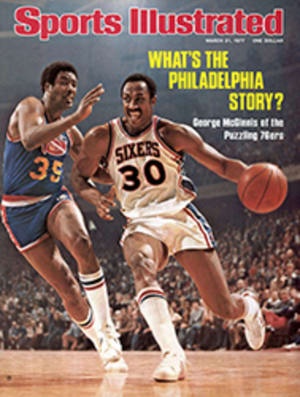
Now this is one way to travel light
On the flight that Frank Shorter took from his home in Boulder, Colo. to New York for last October's New York Marathon, his seatmate, a running friend named Jim Lillstrom of AMF/Head in Boulder, asked where he could get comfortable, functional shorts. "I can't find them, either," Shorter said, "and I need them for my new running gear shop. The best come from Europe, but only in limited quantities, and they take months to get here." As legend will soon have it, the pair simultaneously shouted, "Hell, let's make our own!"
The two were joined by another businessman-cum-marathon runner, John Kubiak of Seattle, who designs and manufactures ski wear, and the three settled down to produce running clothes designed by runners for runners.
Whether they be joggers or world-class competitors, runners have long been dissatisfied with existing outfits. "My first time on an international team I just took my Yale running jersey, a typical fishnet nylon top, and turned it inside out," Shorter says. "I had someone sew the letters USA on it, and that's what I wore, plus a pair of my old shorts." Given a choice, runners prefer clothes made of "breathing" fabrics—those that let the body regulate its own heat and allow moisture to evaporate through a layer of ventilated fabric such as mesh or fishnet. "Wicking," as this process is called, helps keep a runner from getting wet and clammy. Weight is another concern. Shorter recalls one marathoner at the Munich Olympics who stayed up all night before the race, shaving milligrams from his shoes to make them lighter. Many runners are compulsive about carrying even an extra ounce. Think of it this way: a runner takes about 1,600 steps in a mile, so in a six-mile race he will take some 9,600 steps. Being burdened by an extra ounce will, in effect, mean lifting 600 excess pounds.
After returning to their homes, Shorter and his associates set about implementing their midair inspiration, and by December were ready to order labels designed by Lillstrom from a poster depicting Shorter in full stride. Kubiak made patterns and samples in Seattle and sent them to Shorter for testing, and in February, Frank Shorter Running Gear made its debut at the Chicago Sporting Goods Show. The partners received $10,000 in orders within three days.
"Most of them came from other runners who own their own shops," says Shorter's wife Louise. "They came and looked, and sat right down to write their orders. They knew what they were looking for. On the other hand, the large department stores passed us by. They are not close to the sport and don't yet understand the special problems of runners."
Problems of weight and ventilation are solved in Shorter's AW50, an all-weather suit (50 stands for 50-50, i.e., unisex) made of tough but lightweight down-proof nylon, such as is used in ski clothing. The jacket weighs eight ounces, the drawstring pants, which do not creep up or bind around the leg, weigh 5.92. Fine, tightly-woven fabric of this quality stays soft and will not stiffen even in freezing temperatures.
Shorter, who runs 120 miles a week, sometimes trains at 10° below zero and recommends that in such weather one wear several layers under the AW50: long underwear, a turtleneck and a warmup suit. And he suggests wearing a wool cap under the detachable hood of the jacket, which also has a built-in face flap to cover the mouth. As the runner moves he may generate enough heat to soak the two inner layers of clothing, but moisture will wick out through the ventilated fishnet fabric on the back of the jacket. The suit, which costs $47.50, is made in eight colors; for road running it is best to wear one of high visibility.
The sleeveless competition shirt called the Singlet GS26 (26 for the number of miles in the marathon) was designed for the sort of hot, humid weather Shorter encountered when he trained in Gainesville, Fla. Soft, lightweight nylon tricot across the upper chest and around the armholes prevents chafing, though for added protection Shorter still tapes his nipples. Fishnet around the torso helps totally ventilate the shirt. The Singlet, which costs $9.50, weighs 3.04 ounces.
The shorts are probably the lightest made in the U.S. According to one runner, "It feels like I'm not wearing anything," but because, in this case, something is a lot better than nothing, there are attached underpants. These eliminate the need for separate underwear and minimize discomfort and chafing. The Shorter Short SS455M is indeed three-quarters of an inch shorter than standard styles (here the 455M indicates the average mile one has to run to achieve world-class time in the marathon). The shorts have a minuscule pocket with a Velcro closing, just large enough to carry a key or a dime for a phone call if one is not obsessive about the extra weight. Men's shorts weigh 3.2 ounces, and for summer running the combined weight of the shorts, Singlet and a pair of 10-ounce shoes adds up to slightly more than a pound—without a key or dime in the pocket, that is. The women's shorts, which are slightly modified for better fit, weigh 2.24 ounces. Each costs $9.75. There is also an assortment of colored Shorter Running Gear T shirts made of 100% cotton, which go for $4.50 each. And Shorter doesn't stop here. "We're even into socks now," he says, "from wool to pure cotton and cotton with Orion. We agreed not to cut corners, not even on socks. Ours are bulky and absorbent. They're going to cost a little more, but they'll be worth it."
Because so many people have heard about the gear and have been trying to order by phone, the company has decided to put out a catalog, but customers have to be on the spot to take advantage of the shop's library specializing in books on jogging and training (for instance, The Athlete's Foot).
Shorter feels the shop is going to enable him to concentrate on training for a full year, or year and a half, before the Moscow Olympics. "That's what other people do. Apart from running, zero."
Shorter, a lawyer, has checked out the effect of all this on his amateur standing. "I can't let someone else pay me, and endorse things," he says, "but the AAU has said that as long as I have the principal financial interest in the store and actually work at it, it's O.K. This has been done in other countries for years."
Given the look of the market, the chances that the store will do well enough to let him take off are O.K., too. Running is becoming virtually the U.S. national amateur sport.
Lillstrom, whose title on the firm's board of directors is "Prince," is an example of someone now hooked on running. "I'd always considered myself to be a weekend athlete," he says. "But even a casual athlete can't limit his exercise exclusively to weekends because he's going to end up not being able to get out of bed on Monday. I didn't understand this until I was 30 or 31 years old. Then it finally dawned on me why I wasn't enjoying skiing as much, and why I was getting beaten at tennis. I wasn't fit. So two years ago I began running to stay in shape for skiing and tennis.
"But running quickly became an end in itself. Last summer I played tennis just twice. Instead of playing in tennis tournaments, I entered a 10,000-meter race, two marathons and a 15.7-mile hill climb. Even so, it didn't occur to me until the end of the year that running was my sport. It is the kind of thing people take up to test themselves, the way people enter local tennis or handball tournaments, or NASTAR, if they're skiers.
"If one jogs regularly, whatever the weather, he will enjoy himself that much more. And eventually, for guys like me, running becomes a drug. We absolutely must have that 'running fix' or we hate ourselves. I can't think of anything I enjoy more than getting up on a nice crisp morning and going out 'cruising.' When I was training last summer in Boulder for my second marathon, I used to just take off straight up Flagstaff Mountain in a pair of running shoes and shorts and a jock, that's all. I felt like an animal. It's a nifty feeling. You do a little rock climbing, run through streams—it's called fartlek in Swedish, speed-play, a jaunt in the woods."
As for Shorter's running, he now works eight hours a day, but at odd times. "I set my work schedule around my training." The whole store, in fact, is geared to running. The employees work out their hours among themselves so they can all get their training in. A typical day in Boulder: salesperson and marathoner Cherrie Bridges runs to the shop. Shorter runs to the bank. New partner and Comptroller Rob Yahn runs to Shorter's house, while hill-runner Charlie Vigil runs the shop. Even Louise Shorter takes time from sewing and modifying samples to run about five miles a day. There is a locker/shower room for everyone to clean up in after all this. "It's the first thing we put in," says Shorter. "Even before the cash register."
Being participants in the sport, the group knows the gear better than anyone else. They all test the clothes that Kubiak makes, and everyone runs in everything. The board members even have business meetings on the hoof.
"That's a good time to talk to Shorter," says Lillstrom. But he adds, "After seven miles, usually Frank is doing all the talking."
PHOTO
Taking it all in stride, famed marathon man Shorter is suited up in his own racy running gear.
PHOTO
There's a penny-pinching pocket for key or coin.
PHOTO
Ventilation is the inside story on the jacket.
PHOTO
Shorter shorts and shirt weigh 6.24 ounces.
PHOTO
High on a windy hill Jeanne Lillstrom, Lou Shorter and Cherrie Bridges run in all-weather suits.

